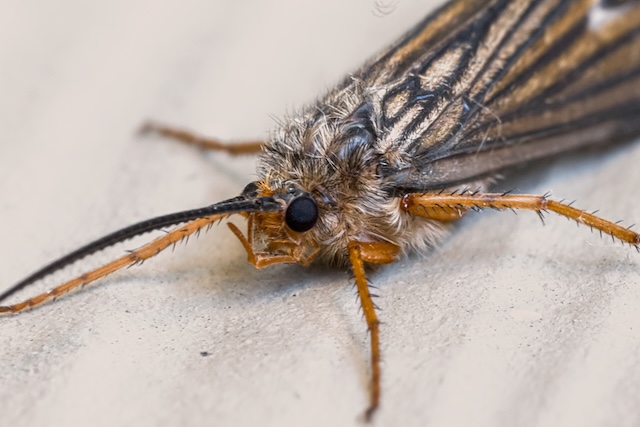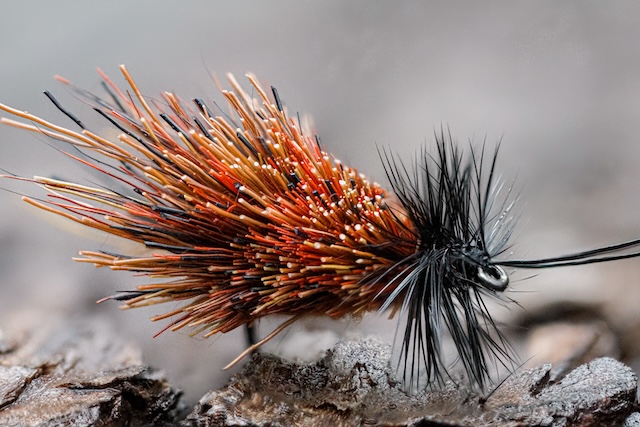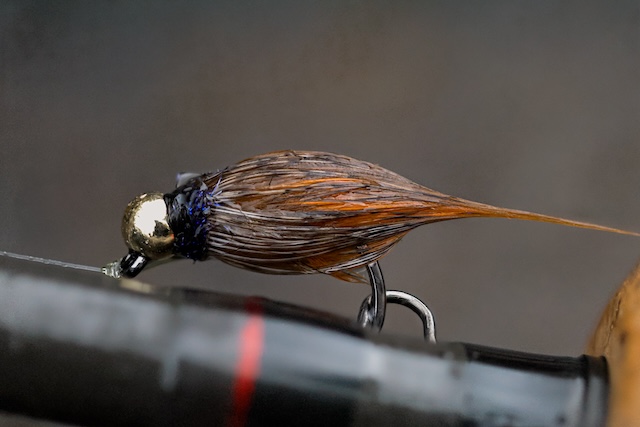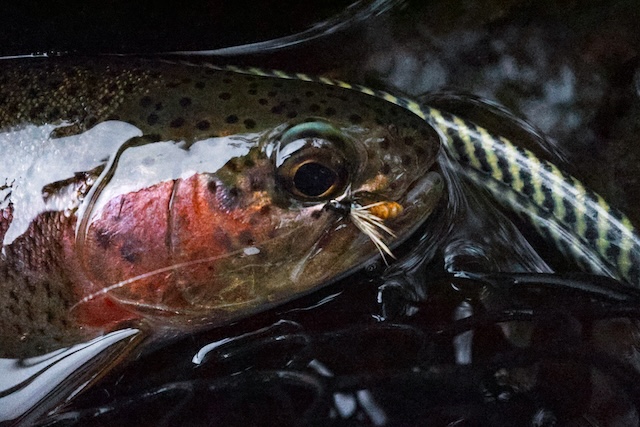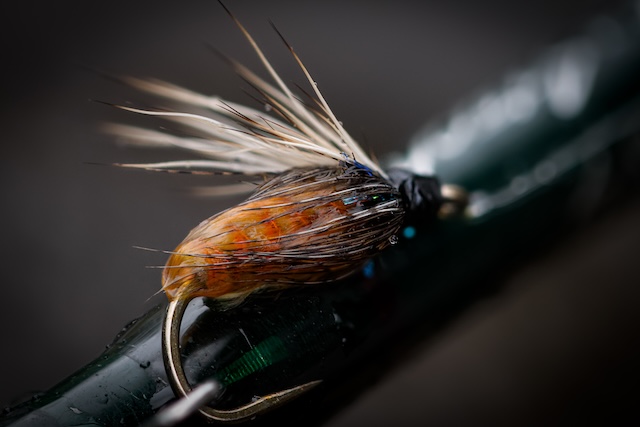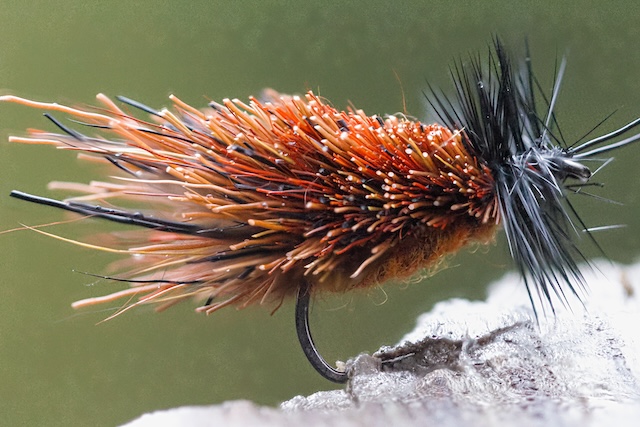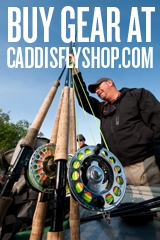Many of us wait with great anticipation for fall weather. The fall colors, a break from the heat and smoke, salmon, mushrooms, bird season, cooler weather, but most importantly the October Caddis. This is an especially difficult time of year because opportunities are abundant for a day off, but as we all know, time is limited. This fall I urge you to make time to fish the October Caddis hatch and enjoy the Fall colors from the water. If you have fished it before, I know you don’t need any convincing to make time for a day on the water fishing the last big bug hatch of the year.
Few caddisfly species rival the size of the massive October Caddis. Also known as the Great Autumn Brown Sedge, this extra large caddisfly is hard to miss. These insects are large, pushing 1.5 inches. This is massive compared to the much smaller caddisflies we are used to. They sport light brown striated wings and a large gold/orange abdomen. They are easily seen fluttering around, when I first saw one, I thought it was a hummingbird or tiny bat. With their wings open and fluttering they look massive. Another telltale sign that the hatch has begun is the presence of pupal shucks on stream side rocks.
October Caddis are most often seen in the evenings when they become most active. You can readily find them in the evenings fluttering around or see the females ovipositing in slower more calm water. Caddisflies are easily distinguished from other insects by their unique flight pattern. They flutter erratically and look like they’ve had too much to drink. This “drunken” flight characteristic is exclusive to caddisflies. Females oviposit, or deposit eggs, in slower water by diving to the water’s surface and dropping eggs each time she dips her abdomen in the water. During the day, these insects hold tight in stream side vegetation only to emerge in lower light conditions. You can have increased daytime activity on especially overcast days, these will often be accompanied by BWO’s on days like this.
October caddisfly are in the case building family of caddisflies. This means the larvae make large rock cases that they live in carry around on the bottom of the river. As fall approaches, they move their case to a suitable location and anchor it to a rock on the river’s bottom. They then close themselves in their case and pupate. Their emergence as a pupa happens in the evenings, so often you do not see actively emerging insects as we do more often with other caddis species and mayflies. What you will see, once things get going, is stream side rocks littered with pupal shucks. Fish gorge on ascending pupa, so swinging wet flies mimicking these large pupa is extremely effective.
Tactics
Tactics for approaching the October Caddis hatch can be broken into two separate categories for simplicity: things happening above the water and below. Generally searching subsurface is more fruitful for this hatch, but surface eats for Octobers are especially memorable.
Pupa
Pupa are especially helpless compared to their more developed counterpart: winged adults. Fish know this and expounding energy chasing pupa is generally rewarded with a meal more often than adults on the surface. Trout are especially aware of their energy expounded vs calories consumed, so thinking like a trout helps you catch more of them. There are two different ways to present pupa to trout.
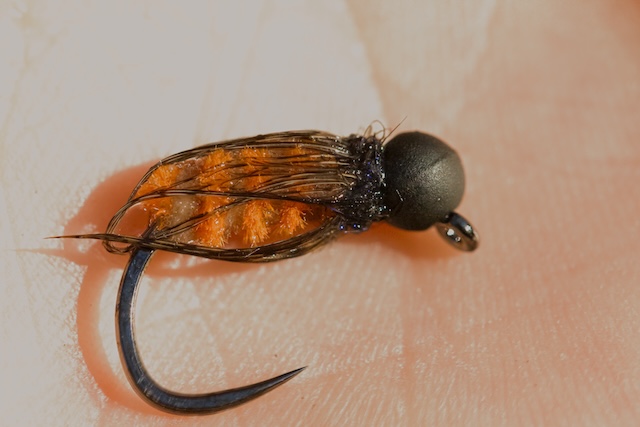
Dead drifting pupa is easiest to start with as it is no different than running nymphs under an indicator or on a Euro stick. Running flies along a seam, dead drifted often yields eats. Fly selection is intuitive for this hatch. October Caddis pupa are big and orange, and your nymphs should be too.
Below are some shop favorites for nymphing: Jigged Mega Prince, Anderson’s Tungsten Bird of Prey October Caddis, Flagler’s October Caddis Jig, Caddy Shack October Caddis, Orange TJ Hooker, Nemo’s Septober Caddis Pupa, MFC Jigged Pearl Rib Perdigon: Firestarter, J’s October Mop, Loren’s Stud, Orange Jigged Duracel.
Swinging wet flies is an alternative approach to fishing subsurface that is much more animated than the traditional dead drift. When done correctly, it mimics an insect ascending from the river bottom to the surface. Casting upstream coupled with several upstream mends gives your flies time to sink. Once they pass you, pinch your line to your cork and hold tight. The tension on your fly line will pull tight and begin to “swing” your flies across the current towards your bank. As things pull tight this lifts flies from the river bottom, effectively mimicking an ascending insect. Classic wet flies with a soft hackle work fantastic for this. I like to pair a heavy nymph with a lighter soft hackle off the back; this aids in getting your flies down quick. When fishing with an indicator setup, you can lets your flies “swing” back towards you at the end of the drift.
Here are some shop favorites for swinging: Orange Jigged Duracel, Nemo’s Septober Caddis Pupa, Bird’s Swinging October Caddis, #12 Partridge and Orange, RIO’s Morrish Deep October Pupa, Tungsten October Caddis, and Anderson’s Tungsten Bird of Prey October Caddis.
Winged Adults
October Caddis dry fly eats are really what everyone is after. Throwing one of these large dry flies can cause explosive eats by large fish. Every Fall I have at least one memorable eat from a massive fish at dusk on an October Caddis dry. Females ovipositing in the evening are a big proponent in fish seeing these adults. Finding slack water near riffles are both where large fish wait, and where female caddis oviposit their eggs. Skating caddis can be effective as well for this hatch. It is essentially swinging a dry fly as you would with a wet fly. Sometimes casting a dry and animating it with tiny strips can entice big fish to surface as well. The first list of flies below are general dry flies that should be fished solo, or with an additional trailing small dry like a BWO or smaller #16 caddis. The second list is for running a fall dry-dropper setup. Note: the first list of flies are ones you can skate and skitter, not flies from the more buoyant second list.
Here are some options for dries: Parachute Madam X: Orange, Kingfisher Godlike Caddis, Rossenau’s Rocktober Caddis, Rubber Leg Stimulator: Orange, J’s October Hi Tie Caddis, Morrish’s Foam October Caddis , Stimulator Orange, Elk Hair Caddis Orange, Burkus’ Sedgeback October Caddis, Better Foam Caddis, Advanced Rubber Leg Stimulator: Orange, or Nicks favorite The Norm Woods Special.
Here are some more buoyant dries that can be ran with a nymph below: Swisher’s Foam PMX, Naked Chubby Chernobyl: Orange, and Hi-Vis Micro Chubby: Orange
Tying Tutorials
For all of you fly tiers out there, here is a list of several October caddis patterns we have done. Note: we will be releasing an October Caddis dry and jigged chenille pupa any day now, so stay tuned. A sneak peak of these bugs can be seen in the article above.
If you have any additional questions regarding this hatch swing by the shop. We are happy to answer any questions, and get you geared up for an awesome time on the water.
-Simon

